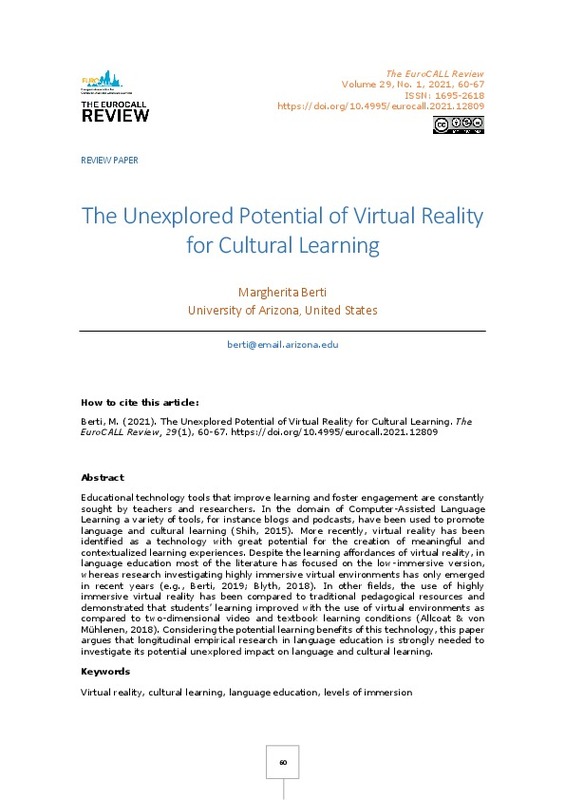Allcoat, D., & von Mühlenen, A. (2018). Learning in virtual reality: Effects on performance, emotion, and engagement. Research in Learning Technology, 26, 1-13. https://doi.org/10.25304/rlt.v26.2140
Barab, S. A., Hay, K. E., & Duffy, T. M. (1998). Grounded constructions and how technology can help. TechTrends, 43(2), 15-23. https://doi.org/10.1007/BF02818171
Berti, M. (2019). Italian open education: virtual reality immersions for the language classroom. New Case Studies of Openness in and beyond the Language Classroom, Research-publishing. net, 37-47. https://doi.org/10.14705/rpnet.2019.37.965
[+]
Allcoat, D., & von Mühlenen, A. (2018). Learning in virtual reality: Effects on performance, emotion, and engagement. Research in Learning Technology, 26, 1-13. https://doi.org/10.25304/rlt.v26.2140
Barab, S. A., Hay, K. E., & Duffy, T. M. (1998). Grounded constructions and how technology can help. TechTrends, 43(2), 15-23. https://doi.org/10.1007/BF02818171
Berti, M. (2019). Italian open education: virtual reality immersions for the language classroom. New Case Studies of Openness in and beyond the Language Classroom, Research-publishing. net, 37-47. https://doi.org/10.14705/rpnet.2019.37.965
Blyth, C. (2018). Immersive technologies and language learning. Foreign Language Annals, 51(1), 225-232. https://doi.org/10.1111/flan.12327
Chen, C. J. (2009). Theoretical bases for using virtual reality in education. Themes in Science and Technology Education, 2(1-2), 71-90.
Dawley, L., & Dede, C. (2014). Situated learning in virtual worlds and immersive simulations. In J. M. Spector, M. D. Merrill, J. Elen, & M. J. Bishop (Eds.), Handbook of research on educational communications and technology (pp. 723-734). New York: Springer. https://doi.org/10.1007/978-1-4614-3185-5_58
Fowler, C. (2015). Virtual reality and learning: Where is the pedagogy? British Journal of Educational Technology, 46(2), 412-422. https://doi.org/10.1111/bjet.12135
Freina, L., & Ott, M. (2015). A literature review on immersive virtual reality in education: State of the art and perspectives. eLearning & Software for Education, 1, 133-141.
Huang, H. M., Rauch, U., & Liaw, S. S. (2010). Investigating learners' attitudes toward virtual reality learning environments: Based on a constructivist approach. Computers & Education, 55(3), 1171-1182. https://doi.org/10.1016/j.compedu.2010.05.014
Jacobson, J. (2017). Authenticity in immersive design. In D., Liu, C., Dede, R., Huang, & J., Richards (Eds.), Virtual, augmented, and mixed realities in education (pp. 35-54). New York: Springer. https://doi.org/10.1007/978-981-10-5490-7_3
Lin, T. J., & Lan, Y. J. (2015). Language learning in virtual reality environments: Past, present, and future. Journal of Educational Technology & Society, 18(4), 486-497.
Liu, D., Bhagat, K. K., Gao, Y., Chang, T., & Huang, R. (2017). The potentials and trends of virtual reality in education. In D., Liu, C., Dede, R., Huang, & J., Richards (Eds.), Virtual augmented, and mixed realities in education (pp. 105-130). New York: Springer. https://doi.org/10.1007/978-981-10-5490-7_7
Lloyd, A., Rogerson, S., & Stead, G. (2017). Imagining the potential for using virtual reality technologies in language learning. In M. Carrier, R. M. Damerow, & K. M. Bailey (Eds.), Digital language learning and teaching: Research, theory, and practice (pp. 222-234). Abingdon: Routledge. https://doi.org/10.4324/9781315523293-19
Sadler, R. (2017). Virtual worlds and language education. In S. L. Thorne & S. May (Eds.), Language, education and technology (pp. 375-388). New York: Springer International Publishing. https://doi.org/10.1007/978-3-319-02237-6_29
Schott, C., & Marshall, S. (2018). Virtual reality and situated experiential education: A conceptualization and exploratory trial. Journal of Computer Assisted Learning, 34(6), 843-852. https://doi.org/10.1111/jcal.12293
Schwienhorst, K. (2002a). The state of VR: A meta-analysis of virtual reality tools in second language acquisition. Computer Assisted Language Learning, 15(3), 221-239. https://doi.org/10.1076/call.15.3.221.8186
Schwienhorst, K. (2002b). Why virtual, why environments? Implementing virtual reality concepts in computer-assisted language learning. Simulation & Gaming, 33(2), 196-209. https://doi.org/10.1177/1046878102033002008
Scrivner, O., Madewell, J., Buckley, C., & Perez, N. (2019). Best practices in the use of augmented and virtual reality technologies for SLA: Design, implementation, and feedback. In M. L. Carrió-Pastor (Ed.), Teaching language and teaching literature in virtual environments (pp. 55-72). New York: Springer. https://doi.org/10.1007/978-981-13-1358-5_4
Shih, Y. C. (2015). A virtual walk-through London: Culture learning through a cultural immersion experience. Computer Assisted Language Learning, 28(5), 407-428. https://doi.org/10.1080/09588221.2013.851703
Shih, Y. C. (2018). Contextualizing language learning with street view panoramas. In Y. Qian (Ed.), Integrating multi-user virtual environments in modern classrooms (pp. 74-91). Hershey: IGI Global. https://doi.org/10.4018/978-1-5225-3719-9.ch004
Slater, M. & Wilbur, S. (1996). A framework for immersive virtual environments (FIVE): Speculations on the role of presence in virtual environments. Presence: Teleoperators and Virtual Environments, 6(6), 603- 616. https://doi.org/10.1162/pres.1997.6.6.603
[-]








